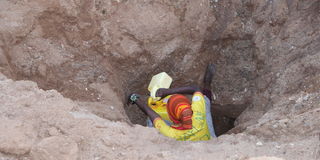Developing story: Iranian President Ebrahim Raisi confirmed dead in chopper crash
Why water is at the core of national development

A 14-year-old girl fetches water from a 20-feet sand dam at Toggoi seasonal river near Modogashe Town in Isiolo County. Despite Kenya being in the tropics, it is water-deficient due to the adverse effects of climate change.
What you need to know:
- Reducing on unnecessary water wastages—at Sh11 billion annually—due to inefficiencies will save a huge portion of public finance to be channelled to bottom-up blueprint priorities.
- The proposal to foster public-private partnerships in the water and sanitation subsector will bridge the financing gap as well as fast-track investments to accelerate the pace of realisation of the water for all goals.
- A productive nation would be one that invests in securing the environment.
President William Ruto’s pronouncements in his inaugural speech and at the United Nations General Assembly have sent optimism of a new dawn among Kenyans, where the country shifts to growing productive capacity as a pathway toward higher prosperity that will impact disposable incomes for most Kenyans.
Key striking mentions in the President’s speech were the focus on climate change and building back better from the bottom, signifying a paradigm shift.
Trickledown economics has had Kenyans wait longer than expected for inclusive economic growth and development to fall to the majority at the bottom.
This is why a shift to embolden the bottom-up approach—and the creation of economic incentives such as subsidies to productive sectors, affordable credit and assuring markets—would transition Kenya into a prosperous nation.
It is now time to chart a new destiny for ourselves in the new dispensation so as to realise our developmental needs.
The Common Agricultural Policies (CAP) of the European Union offer lessons for Kenya’s focus to stimulate productivity.
EU-CAP is a deliberate move by the most integrated and wealthy region to spur rural development, create wealth for the rural agricultural community and provide food at affordable prices, assuring food security.
Despite Kenya being in the tropics, it is water-deficient due to the adverse effects of climate change.
With challenges such as the increase in non-revenue water and high costs of water and sanitation infrastructure, more is needed in investments in new technologies such as new modern pipelines and advanced metering solutions, or Smart meters).
Reducing on unnecessary water wastages—at Sh11 billion annually—due to inefficiencies will save a huge portion of public finance to be channelled to bottom-up blueprint priorities.
The proposal to foster public-private partnerships in the water and sanitation subsector will bridge the financing gap as well as fast-track investments to accelerate the pace of realisation of the water for all goals.
Forest cover
A productive nation would be one that invests in securing the environment.
That is where the foundation of a productive nation lies. Kenya has had a target for increasing the forest cover to over 10 per cent. It’s time we raised it to over 20 per cent.
Increased forest cover would guarantee high quality and quantity of water supply in rural and urban areas.
Many towns and cities are faced with an acute shortage of water and sanitation services, partly due to a fast-growing population.
The Kenya Vision 2030 means huge investment is needed so that all Kenyans at large can be guaranteed of the Sustainable Development Goals (SDGs)—for example, Nos. 1, 2, 3 and 6, on No to poverty; No to hunger; Good health; Clean water and sanitation, respectively—while prioritising the needs of women, girls, children, people with disabilities and the elderly.
Mr Biwott is the managing director, Eldoret Water and Sanitation Company Ltd (Eldowas). [email protected].





